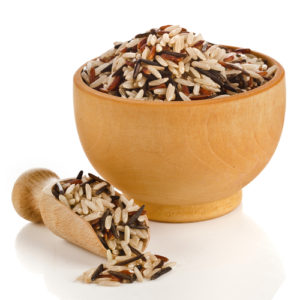Ask Mr. Pedometer and Friends…
March 20, 2019
Q: Mr. Pedometer, you encourage us to “eat right,” but do you have some suggestions on a Fast Way to Make Food Healthier?
A: Consumer Reports on Health for April 2019 includes an article entitled “The Fast Way to Make Food Healthier: Expert tips and tricks to help you put together nutritious and delicious meals and spend less time in the kitchen.” Sound impossible? Here are five suggestions:
-
PACKAGED GRAIN MIXES – These are a great
 start, just requiring boiling water and adding a seasoning packet, but Susan Saffel-Shrier, M.S., R.D., and certified gerontologist and associate professor at University of Utah, says they become much healthier with these tips:
start, just requiring boiling water and adding a seasoning packet, but Susan Saffel-Shrier, M.S., R.D., and certified gerontologist and associate professor at University of Utah, says they become much healthier with these tips:-
Choose a product with whole grains (such as wild rice, quinoa, or whole-wheat couscous)
- Use only half the seasoning packet, to get flavor, but with less sodium
- Add protein by mixing in chopped chicken, beans, or tofu, then top it off with almonds or sesame seeds
- Stir in a bag of stir-fried or steamed cauliflower rice to stretch the grain while retaining its consistency
-
-
CANNED OR BOXED SOUP – Stretch one soup into more than one healthy, complete dinner :
- Add a bag of microwave steamed frozen vegetables, such as cauliflower, peas and carrots, or spinach
-
Mix in a can of low-sodium beans (like chickpeas or kidney beans) for fiber and protein
- Serve it on top of half a cup of a whole grain, like brown rice or farro
- Add a cup of water to dilute the sodium. With the addition of other ingredients above, this can become two meals.
-
SANDWICHES – “Any meal that doesn’t require silverware to eat definitely falls into the ‘easy’ category,” the article notes, and what could be easier than a sandwich? However, notes Lauri Wright, Ph.D., R.D.N, chair of the nutrition department at the University of North Florida, “Many times veggies and fibers are missing from sandwiches, while they can still be high in calories, salt, and fat.” Here’s the fix:
-
Start with whole-grain bread, not only for heart-healthy fiber but also to help the meal feel more satisfying
- Reduce the amount of cold-cuts (which may be high in sodium) and add instead cucumbers, sliced peppers, shredded carrots, spinach, or, of course, lettuce.
- Substitute mashed avocado or hummus for mayonnaise (which “adds calories and fat but little valuable nutrients”). The substitutes add flavor, texture, and nutrients (including fiber and potassium).
-
-
FROZEN DINNERS – Sure, they’re easy and may be tasty, but beware of the amount of calories, salt, and fat they contain “Look for meals that have between 300 to 500 calories, less than 4 grams of saturated fat and 600 mg of sodium, while containing 5 or more grams of fiber and 10 to 20 grams of protein,” says Wright. Then…
- Serve it with a big side salad
-
Add a bag of frozen, non-starchy vegetables (such as zucchini) that you have steamed or microwaved – and possibly mix it right in with the frozen meal, in a larger bowl, to extend the sauce and add extra fiber and nutrients without adding many calories
- Finish the meal with fruit, like an orange or sliced watermelon. These are high in potassium “which helps your body excrete sodium and therefore can help keep your blood pressure low.”
-
COLD CEREAL – Okay, who hasn’t used this as a quick meal? “Cereal is a grain, so to make it a complete meal, add protein and fruits or veggies,” Wright says.
- Choose a whole-grain cereal with little, if any, added sugars
-
Add fruit, such as defrosted frozen blueberries or a slicked banana
- Sprinkle on nuts or seeds, like almonds or pumpkin seeds, for crunch and protein
- Use cereal as a base for a parfait, by layering it with yogurt, berries, and flax seeds
I hope one or more of these suggestions will help you “eat right” without an enormous amount of effort. We all need to…
EAT RIGHT, MOVE MORE, AND SLEEP WELL TO BE WELL.